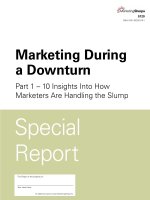HOW COMPANIES ARE MARKETING ONLINE: A MCKINSEY GLOBAL SURVEY ppt
Bạn đang xem bản rút gọn của tài liệu. Xem và tải ngay bản đầy đủ của tài liệu tại đây (360.95 KB, 10 trang )
A McKinsey global survey of marketers shows that companies are using digital tools—from
Web sites to wikis—most extensively for customer service, least in pricing. Two-thirds are using
digital tools for product development, almost as many as are advertising online.
Respondents consider online ads to be as useful for brand building as for direct response. Spending is
expected to increase on all types of online advertising vehicles over the next three years.
In 2010 just over half of all respondents expect their companies to be getting 10 percent or more
of their sales from online channels—twice as many companies as have hit that mark today.
And 11 percent expect to be spending a majority of their advertising budgets online by then.
Most companies today don’t integrate their online and offline marketing efforts; companies that use
online tools across the full spectrum of marketing activities are much more likely to do so.
Jean-François Martin
How companies are marketing online:
A McKinsey Global Survey
2
Source: July McKinsey Quarterly survey of business executives
A survey of marketers from around the world shows where online tools are most important,
how they’re being used, and on which ones companies plan to spend more.
How companies are marketing online: A McKinsey Global Survey
Throughout the brief history of the
Internet,
expectations have run high for it to
“change everything.” A McKinsey survey of
marketing executives from around the world
shows that in marketing, things are starting to
change: companies are moving online across the
spectrum of marketing activities, from building
awareness to after-sales service, and they see
online tools as an important and effective
component of their marketing strategies.
Executives also indicate, however, that they are
making less frequent use of digital tools—from
familiar ones such as e-mail and informational
Web sites to new possibilities such as wikis and
virtual worlds—than their importance would
suggest. A lack of capabilities at companies and
their marketing agencies is a critical reason,
respondents say, along with often-cited concerns
such as an absence of meaningful metrics.
Companies use the Web to reach customers
throughout the decision-making process. In
respondents expect a majority of their
customers to discover new products or services
online and a third to purchase goods there. A
majority of the respondents also expect their
companies to be getting percent or more of
their sales from online channels in —twice
as many companies as have hit that mark today.
These expectations appear to be driving plans
for future spending, at least in some areas.
In addition to established online tools such as
e-mail, information-rich Web sites, and display
advertising, survey respondents show a lot
of interest in the interactive and collaborative
technologies collectively known as Web .
for
advertising, product development, and customer
service (see sidebar, “What are emerging
vehicles?”).
Blogs (short for Web logs) are online journals or diaries hosted on
a Web site.
Online games include both games played on dedicated game consoles
that can be networked and “massively multiplayer” games,
which involve thousands of people who interact simultaneously through
personal avatars in online worlds that exist independently of any
single player’s activity.
Podcasts are audio or video recordings—a multimedia form of a
blog or other content. They are often distributed through aggregators,
such as iTunes.
Social networks allow members of specific sites to learn about other
members’ skills, talents, knowledge, or preferences. Commercial
examples include Facebook and MySpace. Some companies use such
systems internally to help identify experts.
Virtual worlds, such as Second Life, are highly social, three-dimensional
online environments shaped by users who interact with and
receive instant feedback from other users through the use of avatars.
Web services are software systems that make it easier for different
systems to communicate with each other automatically to pass information
or conduct transactions. A retailer and supplier, for example, might
use Web services to communicate over the public Internet and automati-
cally update each other’s inventory systems.
Widgets are programs that allow access from users’ desktops to Web-
based content.
Wikis, such as Wikipedia, are systems for collaborative publishing. They
allow many authors to contribute to an online document or discussion.
What are emerging vehicles?
In July McKinsey surveyed marketing executives from public and private companies around the world, representing industries such as business
services, energy, retail, technology, and telecommunications. We asked respondents about the frequency and effectiveness with which they applied Web-based,
digital techniques to ve core marketing functions: sales, service, advertising, product development, and pricing. We also asked about future plans for digital
marketing, including where respondents anticipated spending more money in the future. All data are weighted by
GDP of constituent countries to adjust for
differences in response rates.
Web . technologies, which rely on user collaboration, include Web services, peer-to-peer networking, blogs, podcasts, and online social networks.
3
Source: July McKinsey Quarterly survey of business executives
In four of the ve major areas of marketing, a
majority of executives— percent for service
management and, even at the low end, per-
cent for pricing—say that online tools are
at least somewhat important for companies in
their industries. At least two-thirds of com-
panies are using these tools in all the areas they
deem most important.
However, far fewer are using them frequently;
indeed, the number of respondents who say that
their companies do so is generally signicantly
lower than the number who say that the use of
these tools is very or extremely important
(Exhibit ).
The importance of these tools naturally varies
among industries—for instance, percent
of the respondents in high tech say that advertis-
ing online is very or extremely important for
them, compared with just percent in manu-
facturing. There are also two other likely
reasons for the relatively low use of online tools:
a lack of capabilities to manage them
and the
fact that access to high-speed Internet con-
nections (required for many of these tools) is
uneven (just under half of Europeans have
it, for example, compared with percent of
the US population).
A large group of respondents say that their
companies frequently use online tools for all
ve aspects of marketing. These companies—
with almost half of all the respondents—
are somewhat likelier to be headquartered in
Europe than the panel average (despite the lower
access to broadband there), somewhat likelier to
be in the high-tech industry, and notably less
likely to be in manufacturing. Frequent users
are also much likelier to be public companies
and to have annual revenues of billion or
more. Not surprisingly, this group of
respondents is also the likeliest to describe
online tools as extremely important across the
whole range of marketing activities and, often,
to be using more sophisticated techniques than
other companies do.
Exhibit 1
Usage and
importance of digital
tools
Large public companies are the most digital
% of respondents, n = 410
% of respondents who answered
very/extremely important
For companies in your
industry, how important
are digital-marketing
tools/techniques overall to
each of the following
marketing activities?
To what extent does your company currently
use digital tools/techniques as part of each of
the following marketing activities?
% of respondents reporting
any frequency of use
% of respondents who answered
frequently/very frequently
Service management
93 6269
Sales management
76 4736
Advertising
68 5135
Product development
66 3226
Pricing
40 1812
In this survey, respondents rank insufcient capabilities, internally or at an agency, as a strong barrier to online advertising. Other McKinsey research has shown
that executives also see low capabilities as a barrier to the use of many other online tools (see footnote ).
4
Source: July McKinsey Quarterly survey of business executives
Web-based sales and services were early uses
of the Internet for marketing. Respondents say
that some approaches to them—providing
service information on Web sites, interacting
with customers via e-mail, and executing
transactions on company Web sites—are widely
used (Exhibit ). Most companies focus on
their own Web sites for both sales and services,
but some are experimenting much further
aeld: percent of respondents in the high-tech
industry, for example, say that they are
experimenting with selling in virtual worlds.
Companies that use digital tools frequently
across the marketing spectrum are likelier than
others to be using more complex tools for
online services; percent offer “click to call,”
and more than a quarter offer text chats with
service personnel, compared with percent of
other companies in each case.
The exibility and degree of personalization the
Web offers would seem to make pricing another
natural area for companies to move online.
Nonetheless, companies have been slower to act
there than in any other facet of marketing, and
most don’t think online tools are particularly
important to pricing. More than a quarter say
they are not at all important.
Service leads for now; pricing trails
Exhibit 2
Digitizing sales and
service
Respondents who answered “other” or “none of the above” are not shown.
Link to request a telephone call from a service representative.
Which digital-marketing
tools does your company
use for service?
Which digital channels
does your company use to
sell products or services?
% of respondents whose companies
use digital tools/techniques for sales
management
1
n = 311
Sales Service
% of respondents whose companies
use digital tools/techniques for
service management
1
n = 383
Company’s consumer
Web site
79
Proprietary or external
e-commerce site
42
Proprietary store in
virtual world
8
86
Provision of relevant
information on Web site
78
29
Online ‘click to call’
2
External auction site
6
Hosting a user forum on
corporate site so consumers
can help other consumers
22
Online text chat with
service person
18
Online video chat with
service person
6
A feature that allows consumers to request that a company representative call them.
5
Source: July McKinsey Quarterly survey of business executives
Exhibit 3
Current usage versus
spending
Spending on digital advertising seems set to
increase signicantly. Today a third of the
companies that advertise online are already
spending more than percent of their
advertising budgets there. Three years from
now, twice as many respondents believe they
will be spending at least that much online,
and percent say they will be spending the
majority of their budgets online.
Just over a third of survey respondents are
frequent users of digital-advertising tools
ranging from e-mail to blogs. The share of
online spending currently allocated to each
vehicle is roughly aligned with usage (Exhibit ).
Companies in the group that are frequent
users of online marketing tools for the full range
of marketing activities also use the full range
of online advertising vehicles more actively:
They are more likely to use each vehicle than
companies that are less active online, and they
are particularly likely to be making more use
of video ads, branded sponsorships, blogs, and
social networking.
Online ads: Many vehicles, less integration
Respondents who answered “other” or “none of the above” are not shown.
Base varies insignicantly; respondents reported using more than emerging digital-advertising vehicle.
Usage: blogs = %, social networks = %, wikis = %, widgets = %, virtual worlds = %, online games = %.
How is your company’s current
spending on digital-advertising
vehicles allocated?
Which, if any, of the following
digital-advertising vehicles does
your company use?
% of respondents whose companies use given
digital tool/technique
1
Average of responses, % of digital-ad
spending
2
n = 231
83 31
Display ads
n = 206
73 33
Paid keyword search
n = 175
63 30
Branded sponsorship
n = 135
48 25
Referrals
n = 109
39 18
Video ads
n = 94
33 16
Podcasts
n = 70
25 12
Emerging vehicles
3
n = 149
12–32 14
6
Source: July McKinsey Quarterly survey of business executives
The majority of respondents nd online vehicles
more efcient than traditional media (Exhibit ).
Interestingly, search advertisements—considered
to be the most efcient—rank only third in
usage. However, respondents also say that they
are likeliest to increase their spending on search
and on video ads over the next three years,
while display ads and e-mail are among the least
likely vehicles to gain spending.
Roughly half of all respondents whose
companies use online advertisements say that
they run integrated online and ofine
campaigns. Companies that use online tools
frequently for all marketing purposes are more
than twice as likely to run integrated campaigns
as are other companies percent do so. As
the use of digital tools grows, it seems likely
that integration between online and ofine
campaigns will also increase.
Exhibit 4
Becoming more
digital by 2010
Base varies insignicantly; respondents reported using more than digital-advertising vehicle; gures may not sum to %,
because of rounding.
Blogs, online games, social networks, virtual worlds, widgets, wikis.
Do you expect spending on each
of these digital-advertising vehicles
to decrease, increase, or stay
the same over the next three years?
Compared with traditional media, how
efcient is each of the digital-advertising
vehicles your company uses in reaching
your company’s goals?
% of respondents
Less efficient More efficient
% of respondents
1
Paid keyword search
n = 175
609
5110
n = 231
507
Branded sponsorship
n = 135
4812
Referrals
n = 109
Video ads
n = 94
47
12
4312
Podcasts
n = 70
4016
Display ads
n = 206
298
Emerging vehicles
2
n = 149
20
71
3
7
1
Decrease
Remain the same
Increase
Don’t know
34
51
11
5
20
69
3
8
25
59
6
9
19
74
6
35
54
3
8
31
55
9
6
12
64
1
24
7
Source: July McKinsey Quarterly survey of business executives
Marketers say that online tools help them meet
their goals throughout the customer decision-
making process, sometimes in ways that
contravene the common wisdom about how
these tools are best used. Search advertisements,
for example, were developed to generate a
direct response, but survey respondents say that
the ads are almost equally useful in brand
building. It’s also clear that companies are experi-
menting: respondents describe such a wide
variety of objectives for some vehicles that many
companies still seem to be deciding which
digital-marketing techniques are most effective
for what purposes (Exhibit ).
Although marketers expect to rely increasingly
on digital-advertising vehicles, they recognize
barriers that could slow the adoption of these
tools. The lack of sufcient capabilities at
companies or their agencies is the most signi-
cant concern, for both those that are adver-
tising and those that aren’t (Exhibit ); among
online advertisers, for example, about
percent of responses indicate that insufcient
capabilities are a barrier. Even among
respondents at companies that frequently use
online tools for all marketing purposes, a
full percent of responses highlight capability
barriers to advertising. Other McKinsey
research shows that a lack of online capabilities
extends far beyond the marketing depart-
ment: percent of the respondents to another
global survey said that investing more in
the capabilities of their companies would have
made initial investments in Internet tech-
nologies more effective.
Exhibit 5
Objectives vary among
users of digital tools
Online ads: Meeting many needs, hitting many barriers
% of respondents whose companies use each digital tool/technique
1
Respondents reported using more than digital-advertising vehicle; gures may not sum to %, because of rounding.
What marketing goal do you try to achieve with each of the following
digital-marketing vehicles?
Overall
E-mail, n = 231
Paid keyword search, n = 175
Display ads, n = 206
Branded sponsorship, n = 135
Referrals, n = 109
Video ads, n = 94
Podcasts, n = 70
Emerging vehicles, n = 149
Brand building
25
5
27
36
55
13
33
22
19
Retention
21
37
7
10
24
22
12
33
22
Don’t know
11
6
8
9
4
11
8
14
35
Consideration
21
20
29
18
11
28
30
25
15
Direct response
22
33
29
27
7
27
17
5
9
Top 4 digital-marketing
tools used
“How businesses are using Web .: A McKinsey Global Survey,” The McKinsey Quarterly, Web exclusive, March .
8
Source: July McKinsey Quarterly survey of business executives
Exhibit 6
Adoption barriers
Another frequently cited barrier—insufcient
metrics to measure impact—is counterintuitive
because the ease of measuring returns on
investments is among the key selling points of
vehicles such as paid search.
It’s particularly
notable that more than half of all current
advertisers see insufcient metrics as a barrier—
a proportion signicantly higher than it is
among nonadvertisers. On the other hand,
it’s also notable that some common fears, such
as the idea that online advertising puts a
company’s brand at risk, do not seem to worry
most respondents.
Respondents who answered “other,” “none of the above,” or “don’t know” are not shown.
Online space available for digital advertising within given time period.
Which, if any, of the following barriers did your company have to
address to use or to consider using digital-advertising vehicles?
% of respondents, n = 275
1
Type of barrier
Users
% of respondents, n = 116
1
Nonusers
Insufficient metrics to
measure impact
52 39
Insufficient capabilities
to handle internally
41 40
33
Hard time convincing
management
32
Limited reach of
digital tools
24 27
Insufficient capabilities
at agency
18 9
Not enough high-quality inventory
2
available for purchase
12 4
Brand risk
11 7
Too labor intensive
9 7
For more about measuring returns on online investments, see Thomas D. French, “Confronting proliferation . . . in online media: An interview with Yahoo!’s
senior marketer,”
The McKinsey Quarterly, Web exclusive, June .
9
Source: July McKinsey Quarterly survey of business executives
Collaborative tools such as blogs, wikis, and
social networks are being used in advertising,
product development, and customer service. At
the simplest level, for instance, percent
of the respondents say that their companies host
user forums for customers to help one another.
Just over a third of all survey respondents—and
just over half of those whose companies
advertise online—say that their companies use
some kind of collaborative or interactive tool
to advertise. About percent are using these
tools for customer retention, which ts into the
common understanding that they help build
relationships between customers and companies.
More interestingly, nearly as many respondents,
percent, use collaborative tools primarily for
brand building. The enthusiasm for experi-
menting with these tools is clear: more than a
third of the respondents don’t know what
marketing objective their investments in
collaboration and interactivity serve, yet some
percent of companies’ online-advertising
budgets go to such tools.
Some two-thirds of all survey respondents use
online tools to involve their customers in
product development; about a quarter do so
frequently. The reasons vary notably by
industry—respondents in both nancial services
and manufacturing, for example, focus on
testing concepts and screening ideas, while those
in high tech focus on generating new ideas.
Further, percent of all the survey respondents
are using collaborative product-development
tools, such as initiating discussions in blogs to
test ideas, involving customers in the use of
collaborative design tools, or testing how well
products sell in virtual worlds. Frequent
users of digital tools for all marketing purposes
are much likelier than others to exploit these
collaborative product-development tools.
Collaborating with customers
10
Source: July McKinsey Quarterly survey of business executives
Q
The contributors wish to thank Nicole Baumüller for her signicant role in the execution of this survey.
Contributors to the development and analysis of this survey include Jacques Bughin, a director in McKinsey’s Brussels ofce;
Christoph Erbenich, a principal in the Frankfurt ofce; and Amy Shenkan, a consultant in the San Francisco ofce.
Copyright © McKinsey & Company. All rights reserved.
The evolution under way in digital marketing
reects fundamental changes in consumer
behavior. Already, more and more people use
the Web—instead of books, the yellow pages,
libraries, car dealers, department stores, or real-
estate agents—to search for information. In
doing so, they often become aware of new
products and compare prices.
How far will these shifts go? According to the
marketing executives we surveyed, by the
Web will play a role in the rst two stages of the
consumer decision-making process—product
awareness and information gathering—for a
sizable majority of all consumers, though with
notable variations among industries (Exhibit ).
The expectation that most consumers will seek
out new products online may be a factor in the
plans of companies to increase spending
signicantly on several digital-advertising tools
they see as most useful in building brands.
A smaller proportion of customers, respondents
expect, will use the Web to execute transactions
or access services. Even so, percent of all
respondents expect that their companies will be
making more than percent of total sales
through online channels three years from now,
more than twice as many as do so today.
Further, some companies, particularly the most
frequent users of the full range of online
marketing tools, have already begun integrating
their online and ofine marketing efforts. Most,
however, do not: only percent run integrated
campaigns, and percent use online tools to
inuence ofine sales. As online tools and
techniques take on a larger role in marketing
strategies, these numbers will likely grow,
increasing the possibility of reaching the sizable
number of online customers through successful
efforts that could reap benets ofine as well.
Exhibit 7
The role of digital tools
in 2010
3 years from now, what percentage of customers in your industry do you expect to be
using digital tools/techniques for each of the following activities?
Average of responses, % of usage, n = 410
Becoming aware of
new products
Searching for
information
Comparing prices Buying products/
services
Using services
(eg, after sales)
55
70
50 50
63
83
58
54
41
44
45
34
32
35
33
30
44
61
47
36
Total
High tech
Financial services
Manufacturing
What customers will be doing online









